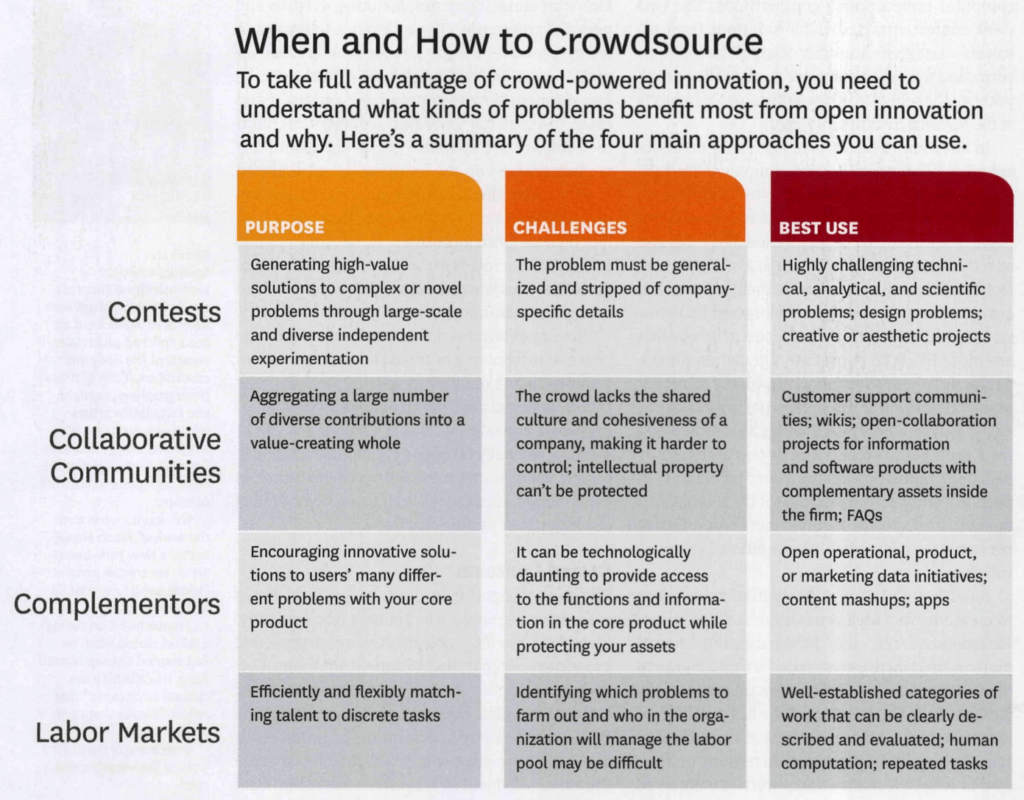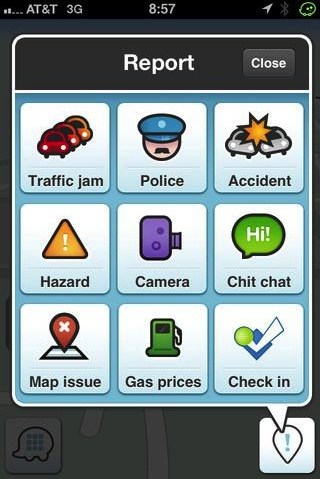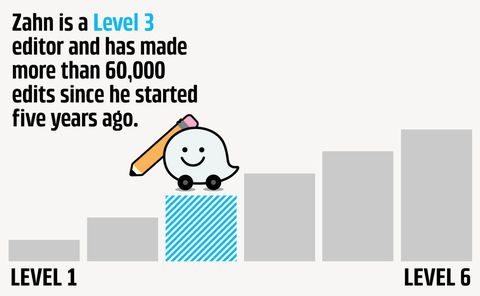How crowdsourcing is changing the Waze we drive

Waze paves the way we are dealing with information about traffic and transportation in cities around the world
With over 100 million users logging in more than 22.5 billion ridden kilometers [1], Waze defines itself as ‘the free, real-time, crowdsourced navigation app powered by the world’s largest community of drivers’. It relies on user data to monitor and relay traffic information for its maps in +185 countries around the globe. Waze finds itself in the center of being the user and the source of crowdsourced information to deliver solutions to the communities it serves. This dual role in the space of distributed innovation poses Waze with challenges and opportunities ahead.

There are three main ways Waze collects data from the crowd: 1) users actively report on live events happening on the road (Figure 2 shows the app screen to report an event); 2) users passively relay information about driving speed and traffic conditions whenever they have the app open in the background; and 3) a network of 500,000 volunteers who constantly edit the maps used in the app [1]. This third application of crowdsourced knowledge requires further attention to uncover its full understanding.

500,000 map editors form a self-organizing community as described in The Principles of Distributed Innovation (Panneta and Lahkani, 2013) [3], and Waze recognizes the value of this resource in offering reliable data to its users. By providing monetary incentives, such as organizing occasional meet ups for top editors, and by structuring the community in tiers, levels and ranks (6 in total) (Figure 3. Depicts an example of ranked editor), Waze has, so far, successfully created a community with competition, collaboration and rewards [4]. Although the track record of success since its creation, concerns still remain that echo those of of Panneta an Lahkani, around the reasons these collaborators would continue to participate for free in helping Waze build better maps for its users. Relying on editors altruism and dedication can prove itself to be a major risk for Waze in keeping its maps up to date and reliable.

On the other side of the distributed innovation process, in 2014 Waze launched its Connected Citizens Program (CCP) by partnering with 10 cities around the world. The goal of the program is to engage with local authorities in a two-way street: Waze provides officials with traffic data, and officials inform Waze of eventual closures, interventions and road maintenance. Manager of the Program Paige Fitzgerald describes the program as ‘taking [the traffic information] and delivering it to government officials, who address incidents in real time’ [5].

Cities such as Jakarta and Los Angeles are now partners with Waze under the CCP and have achieved significant successes in the two-way data sharing partnership. In Ghent, Belgium, authorities have deployed a new circulation plan for traffic that has reduced accidents by 30% and increased the number of cyclists by 27% [6]. In Rio de Janeiro, Brazil, Waze and the CCP supported local officers to organize and mitigate road impact of the 2016 Summer Olympics, which posed a major challenge on the city’s streets, and the two-way partnership helped Waze automatically update its maps with reported road closures that city officials determined [7].
The escalation of the CCP to a new venture within the company has reached a significant speed. In August 2018 Waze celebrated the 600th partner in the program, and the firm continues to sign one new partner per day on average [8]. By looking at the program’s success through the lenses of Waze’s catchy slogan of ‘Outsmarting traffic. Together’ [1], we can understand the huge potential this initiative has in acting as a thought partner for local authorities, who-through access to Waze’s extensive data-can now learn from one another to shape better decisions regarding transportation issues.
In summary, Waze paves the way when it comes to crowdsourcing innovation, be it in a small incremental scale such as map edits, or in larger decisions with real world implications.
Word Count: 728
References
[1]: Waze (2018). Company Fact Sheet. [online] Assets.brandfolder.com. Available at: https://assets.brandfolder.com/pbtsls-1nska8-dxoeew/original/Waze_Company.pdf?_ga=2.186820589.494513673.1542075282-1186534970.1542075282 [Accessed 13 Nov. 2018]
[2] Lakhani, K. and Boudreau, K. (2013). Using the Crowd as an Innovation Partner. [online] Available at: http://web.b.ebscohost.com.ezp-prod1.hul.harvard.edu/ehost/pdfviewer/pdfviewer?vid=1&sid=6d13a76c-b7ad-40c5-b4b5-c1838fadd207%40sessionmgr103 [Accessed 13 Nov. 2018].
[3] Panneta, J. and Lahkani, K. (2013). The Principles of Distributed Innovation. [online] MIT Press Journals. Available at: https://www.mitpressjournals.org/doi/pdf/10.1162/itgg.2007.2.3.97 [Accessed 13 Nov. 2018].
[4] Del-Colle, A. (2015). How Waze Conquered Mapping with Thousands of Volunteers. [online] Popular Mechanics. Available at: https://www.popularmechanics.com/technology/a15624/waze-volunteer-work-force/ [Accessed 13 Nov. 2018].
[5] YouTube. (2015). Waze Connected Citizens Program: Improving Mobility Through Big-Data Partnerships [Short version]. [online] Available at: https://www.youtube.com/watch?v=pcb8IYvOXDc [Accessed 13 Nov. 2018].
[6] Waze Community (2017). Reducing traffic in Ghent city center. [online] Waze.com. Available at: https://www.waze.com/ccp/casestudies/reducing_traffic_in_ghent_city_center [Accessed 13 Nov. 2018].
[7] Waze Community (2016). Improving the Road to Rio. [online] Waze.com. Available at: https://www.waze.com/ccp/casestudies/improving_the_road_to_rio [Accessed 13 Nov. 2018].
[8] Waze (2018). Waze Celebrates 600 Connected Citizens Program Partners. [online] Medium. Available at: https://medium.com/waze/waze-celebrates-600-connected-citizens-program-partners-36945fbceb66 [Accessed 13 Nov. 2018].



Very interesting topic Klaus. Waze has definitively reshaped the road navigation space due to its ability to get both drivers and government officials to work together to create more open information around traffic flows. I do wonder where they go from here though. Logically, the next step after getting all the info on traffic is redirecting people to minimize that traffic, something that I know Google Maps had been doing prior to the Waze acquisition so I’m sure that will be in soon to the extent it wasn’t already. Do you think that might be an area where machine learning would be useful over open innovation? Seems like ML is useful in less creative, more data-driven answer contexts while open innovation is great when trying to come up with new, differentiated insights that don’t come from data analysis per se.
Great post! As you pointed out, relying on the altruism of the network of editors is a major risk that Waze faces. I’m fascinated with how they’ve “gamified” the editing process in order to create incentives (seemingly out of thin air) in order to encourage people to edit the maps for them. Moreover, these individuals seem to do an accurate job in a timely manner despite receiving no tangible compensation for their efforts. I’m curious whether a more disciplined approach can be applied to machine learning to look at historical traffic patterns, notices of construction on municipal websites, Twitter activity, etc. to automate some of this work and make the platform less reliant on individual volunteers. At the same time, I’m curious what other industries might be able to benefit from creating a game-like crowdsourcing platform in order to recruit the work of volunteers in order to advance their business objectives (and to learn from the human volunteers’ activity in order to create a machine learning-based solution).
Awesome article! I wonder if Waze has faced any repurcussions regarding its use of crowd-sourcing traffic data. In my experience with Waze, having to enter when there’s a pothole on the road, police are nearby, or there is significant traffic can distract from the actual experience of driving. Furthermore, I’ve even been shown ads while driving that I’ve attempted to swipe away or get rid of. I understand they are attempting to get very granular data for traffic; however the trade-off is driver attentiveness and safety. I wonder if there is a way for them to more heavily rely on the passive crowdsourced data and their network of map-editors rather than active data from drivers.
Great article! One thing that came to mind when reading the article was how Waze would continue to ensure the accuracy of its data as it grows. I see this being a concern especially as they begin partnering through the CCPs. If government officials will be using the data to respond to issues in real time, I wonder how Waze will ensure that they are continuing to provide accurate information. If government agencies are making major decisions based on the data from Waze and an incorrect decision is made because data is not accurate, this could have significant repercussions.
Great article. I remember being very impressed that a start-up that relied on crowd-sourcing could be a better platform than Google Maps. Then was only more impressed when Google ultimately bought Waze – which for a company like Google is effectively admitting that they, with all their engineering resources, were incapable of building something better. Apple acquiring Shazam is a similar story in my opinion.
When I was commuting daily in the Bay Area, Waze has helped me save countless hours from my commute, so I’m quite invested in this topic! I had no idea that Waze was actually working with local authorities, considering that quite a few people (myself included) use Waze as a way to avoid these local authorities. But I definitely see immense potential in the CCP program, especially in areas where traffic can be a huge source of concern. And like you mentioned, Waze is almost the model platform for demonstrating crowdsourcing innovation. So my question is, where does Waze see itself going from here? It can keep accelerating the speed of its partner signups, but once that is in place, how can they continue to innovate to deliver on their promise of “outsmarting traffic, together?”
Great article! I’m curious about how Waze changes its algorithm as it scales. It already has quite a grasp of the market and I wonder to what extent it factors in the number of app users on a route when it recommends the same path to many drivers. In cities, could it get to a point where it directs traffic out of one jam and into a new one that it created or is it already accommodating for that?
Great read! It would be interesting to see if/how Waze, after being acquired by Google, would scale to reach the entire list of countries covered by Google Maps. It would be easy to predict the scalability of such an app in mature markets such as the US, however, I think it would be extremely difficult to grow in the still-developing markets where Google Maps itself is still struggling to gain traction. Also, regarding government regulation, I am quite skeptical about the global adoption of such platforms, in places which are still conservative when it comes to public/private sector partnerships.
Great article! Waze definitely has transformed crowd sharing data. I wonder what the effect on Waze will be with self-driving vehicles? Will Waze no longer be needed or will it be optimized since the self-driving cars can use the Waze data more efficiently? I think the combination of Waze and self-driving vehicles could be very powerful next step in decreasing traffic and increasing safety on the road.
Thanks for sharing! Like a previous commenter, I am curious about how Waze changed pre and post-acquisition by Google and why Google acquired Waze, rather than setting out to create their own crowdsourcing initiative based on their huge user base. I am also curious about how Google, their maps application and company more broadly, use the information that Waze so effectively crowdsources. It seems like Google Maps has incorporated their own traffic signals (mostly via color along the route and rerouting) into their own application, which may cannibalize use and enthusiasm for Waze.